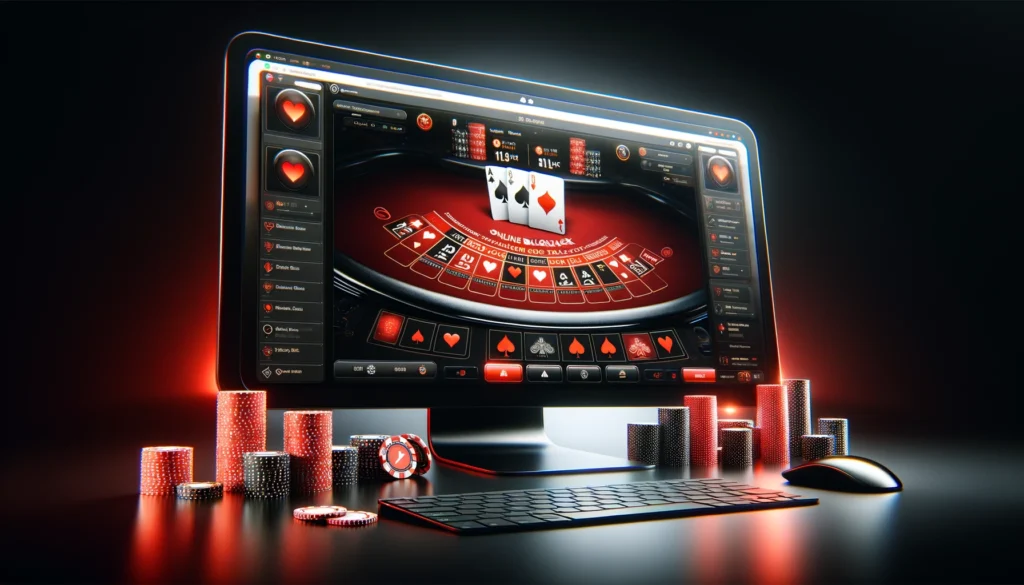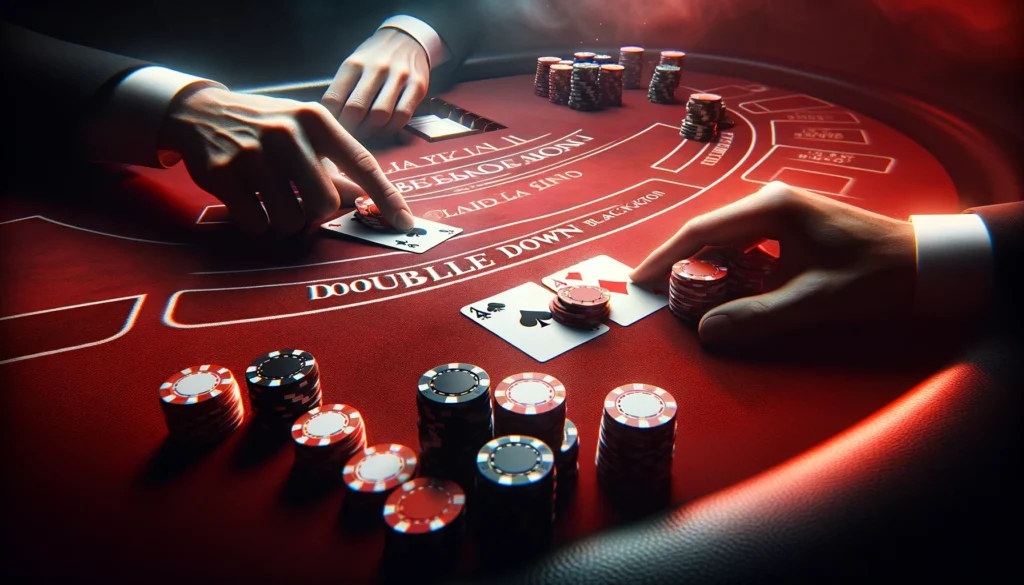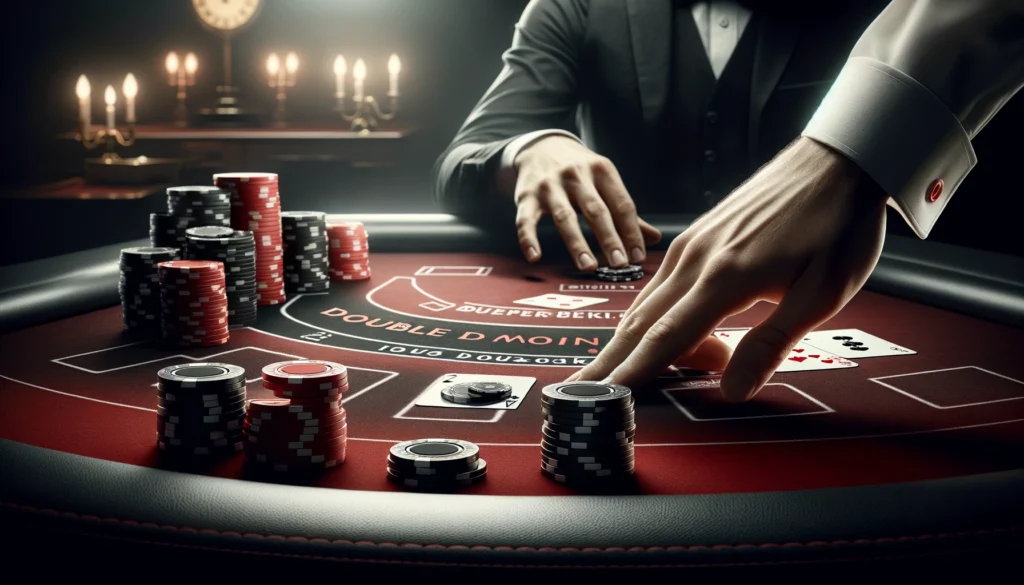Understanding Double Down in Blackjack: Mastering This Strategic Powerhouse
Double down in blackjack is a powerful strategic maneuver that allows players to significantly increase their wager mid-hand. By understanding when and how to utilize this technique effectively, you can elevate your blackjack game to new heights.
Introduction to Doubling Down
Taking the Gamble: Understanding Doubling Down in Blackjack
Blackjack double down is a strategic move that can significantly boost your winnings when you’re dealt a promising hand. It involves increasing your original bet by an equal amount after seeing your first two cards. There’s a catch, though: you’ll only receive one additional card to your hand. This ups the potential reward if you win, but also means you risk losing a larger sum if the hand goes south.

Why Double Down?
The true power of doubling down lies in its ability to capitalize on advantageous situations. By placing a bigger bet when the odds are in your favor, you can significantly amplify your potential returns. This maneuver is especially beneficial when you have a strong starting hand, based on the value of your two cards and the dealer’s exposed card (up card).
Basic Rules of Doubling Down
General Rules: Most blackjack double down rules variations allow doubling down under specific circumstances. Typically, you can double down before hitting, standing, splitting, or surrendering. However, some variations might have additional restrictions.
Variations in Doubling Down Rules: Always check the specific rules at the blackjack table you’re playing at. Here are some common variations:
- Number of Decks: Some casinos might restrict doubling down on certain hand totals with a higher number of decks (e.g., no doubling down on 11 with 8 decks). This is because with more decks, the probability of drawing a specific card you need is lower.
- Dealer Rules: Casinos with a “dealer hits soft 17” rule generally offer slightly more favorable doubling down opportunities compared to those where the dealer stands on soft 17. This is because the dealer is more likely to bust (go over 21) themselves when they hit on soft 17, increasing your odds of winning.
When to Double Down: Seizing the Advantage
The decision to double down blackjack hinges on your initial hand value and the dealer’s up card. Here are some ideal scenarios:
- Hard 9, 10, or 11: These hands are particularly strong against a low dealer up card (2-6). Doubling down capitalizes on the high probability of drawing a card that gets you closer to 21 without exceeding it (busting).
Examples:
- You have a 10 and a 5 (hard 15) and the dealer shows a 4. Doubling down leverages the advantage of potentially drawing a 6 or lower to reach 21.
- You have an 8 and a 3 (hard 11) and the dealer shows a 6. Doubling down offers a good chance of drawing any card (except a 10-valued card or an ace) to make 21.

Risks and Rewards of Doubling Down
Potential Benefits: A successful double down blackjack can significantly boost your winnings. Since you’re wagering more after seeing your initial cards, a win translates to a much higher payout compared to a regular bet. Imagine winning a hand where you doubled down! The thrill and potential return can be significant.
Risks and Mitigation: The risk of doubling down is that you might lose a larger sum if your hand doesn’t improve. Mitigate this risk by understanding the optimal times to double down based on basic strategy charts or through practice with blackjack trainers. These tools can help you identify situations where the potential reward outweighs the risk.
Doubling Down on Soft Hands: A Nuance Worth Exploring
- Soft Hands Explained: A soft hand includes an ace, which can be counted as 1 or 11. This gives you more flexibility compared to a “hard” hand where the ace can only be counted as 1.
- Doubling Down on Soft Hands (16, 17, or 18): While not as common, there are scenarios where double down blackjack on soft totals (such as 16, 17, or 18) can be advantageous. Particularly when facing a dealer’s weak up card (ranging from 2 to 6), this strategic choice can significantly improve your odds. To master these situations, consult a basic strategy chart or practice with blackjack trainers. Keep in mind that even though the total might seem high (16, 17, or 18), the presence of an ace as an 11 allows you to draw a low card and still remain below the critical 21-point threshold.
Understanding Double Down in Blackjack: Mastering This Strategic Powerhouse (Continued)
We explored the core concept of doubling down and ideal scenarios based on hand totals and dealer up cards. Now, let’s delve into how casino rules and specific situations influence this powerful maneuver.
Impact of Casino Rules on Doubling Down
The specific doubling down rules at a blackjack table can significantly impact your strategy. Here’s how some key casino rules influence your decision:
- Dealer Hitting or Standing on Soft 17:
- Dealer Hits Soft 17: When the dealer hits a soft 17, it creates a more advantageous scenario for players. Here’s why: since the dealer is more prone to exceeding 21 by drawing another card, doubling down becomes a strategic move to enhance your hand and boost your chances of winning. For instance, consider doubling down on a hard 9 when facing a dealer’s 6; this choice becomes even more appealing when the dealer adheres to the soft 17 rule.
- Dealer Stands on Soft 17: This rule creates a slightly tighter doubling down strategy. With the dealer less likely to bust, you might find fewer situations where doubling down is statistically the best play. This emphasizes the importance of consulting a basic strategy chart or practicing with blackjack trainers that account for specific casino rules.
- Dealer Hits Soft 17: When the dealer hits a soft 17, it creates a more advantageous scenario for players. Here’s why: since the dealer is more prone to exceeding 21 by drawing another card, doubling down becomes a strategic move to enhance your hand and boost your chances of winning. For instance, consider doubling down on a hard 9 when facing a dealer’s 6; this choice becomes even more appealing when the dealer adheres to the soft 17 rule.
- Number of Decks: Casinos with a higher number of decks (e.g., 6 or 8 decks) might have stricter double down blackjack limitations. For instance, some tables might not allow doubling down on a hand value of 11 with more decks compared to a single or double-deck game. This is because with more decks, the probability of drawing a specific card you need is lower. Always check the table rules regarding doubling down limitations based on the number of decks in play.

Restrictions on Doubling After Splitting Pairs
Another crucial aspect to consider is how splitting pairs interacts with doubling down:
- Splitting and Doubling Down: In most blackjack variations, you cannot double down after splitting a pair. This is because doubling down is typically a pre-emptive maneuver based on your initial two cards, and splitting transforms those cards into two separate hands, altering the original doubling down opportunities.
- Exceptions: Some rare blackjack variations might allow doubling down after splitting pairs under specific circumstances. However, this is uncommon and it’s essential to confirm the rules at the table before attempting such a maneuver. Generally, focus on mastering the core doubling down strategy for un-split hands.
Beyond the Basics: Advanced Doubling Down Considerations
While the core doubling down strategy focuses on hand totals and dealer up cards, experienced players might explore additional factors:
- Number of Decks Remaining: Advanced card counters can factor in the estimated number of decks remaining after the shuffle when making doubling down decisions. With fewer decks left, the probability of drawing a specific card you need increases, potentially influencing your doubling down decision on borderline hands.
- Surrender Availability: Some blackjack variations offer a “surrender” option, allowing you to forfeit half your bet after seeing your initial two cards and the dealer’s up card. If surrender is available, it might influence your doubling down decision in specific situations. For instance, surrendering a weak hand might be preferable to doubling down, especially against a strong dealer up card.
However, these advanced considerations are best explored after mastering the core double down blackjack strategy and understanding basic card counting principles.
Mastering the Art of Doubling Down: Practice and Refinement
Doubling down effectively requires practice and a nuanced understanding of various factors. Here are some tips for mastering this strategic move:
- Consult Basic Strategy Charts: These charts outline the optimal play (hit, stand, double down, or surrender) for various hand combinations and dealer up cards. Start by memorizing the basic doubling down scenarios.
- Practice with Blackjack Trainers: Utilize blackjack training software or mobile apps to simulate real-world gameplay and practice doubling down decisions in a risk-free environment.
- Observe Experienced Players: Watch how experienced blackjack players handle doubling down situations. While not a substitute for your own learning, observing their play can offer valuable insights.